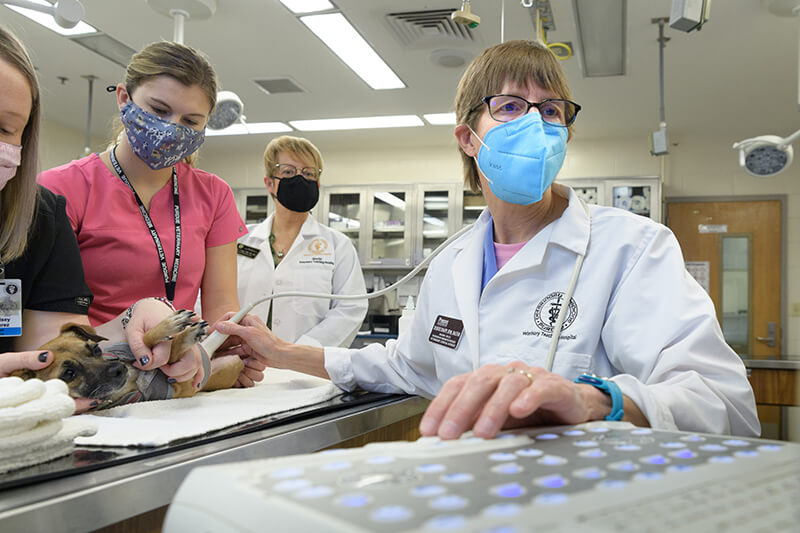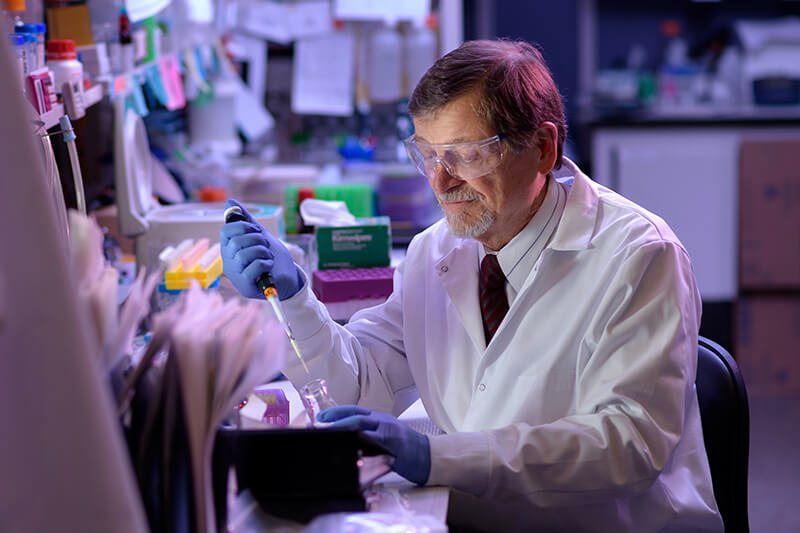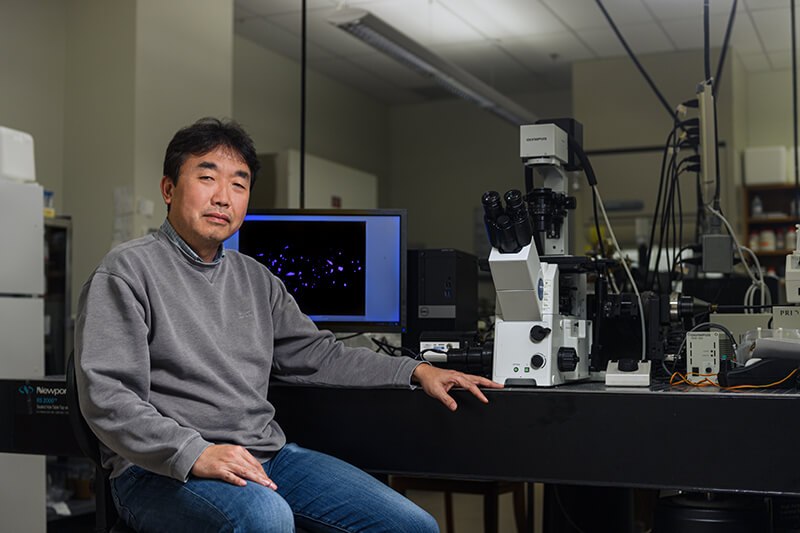December 1, 2020
Treating cancers starts small: More than 100 Purdue scientists study cancer on the cellular level

The Purdue University Center for Cancer Research connects more than 110 researchers from across the university to study cancer on the cellular level. The work in PCCR’s labs advances understandings of cancer prevention, detection, diagnosis and treatment. One of those faculty members is Deborah Knapp, the Dolores L. McCall Professor of Comparative Oncology, who is performing an ultrasound on a dog. PCCR is the nation’s only National Cancer Institute basic laboratory cancer center that includes a college of veterinary medicine. (Purdue University photo/John Underwood)
Drug discovery at heart of Purdue University Center for Cancer Research findings, mission
WEST LAFAYETTE, Ind. — When cancer patients ask about the drug that may save their lives, they don’t expect to hear about zebrafish or fruit flies. Yet this is precisely where the life-saving treatments coming out of the Purdue University Center for Cancer Research begin.
As one of only seven basic laboratory cancer centers recognized by the National Cancer Institute, which is part of the National Institutes of Health, PCCR connects more than 110 researchers from across the university to study cancer on the cellular level. This form of molecular research is the foundation of all drug discovery.
“We study normal cell function in very basic systems like yeast, fruit flies and zebrafish,” said Timothy L. Ratliff, the Robert Wallace Miller Director of the PCCR. “They’re simple models that help us define pathways quite rapidly and effectively.”
The center, which celebrated its 40th year as an NCI-recognized member in 2018, has recently received a five-year accreditation extension as part of the competitive renewal of its NCI basic laboratory cancer center status.
The work in PCCR’s labs advances understandings of cancer prevention, detection, diagnosis and treatment.
Though they may never see a human patient, PCCR researchers do treat naturally occurring cancer in canines. As the only NCI basic laboratory cancer center that includes a college of veterinary medicine, PCCR has the unique opportunity to study canine oncology while giving dogs chances to live longer, fuller lives.
“We actually treat canine cancers,” Ratliff said. “Pet owners are ecstatic that we can extend the lives of their pets, and we utilize this process to better understand cancer in people.”
Work by Deborah Knapp, the Dolores L. McCall Professor of Comparative Oncology in Purdue’s College of Veterinary Medicine and 2017 Purdue Research Foundation Innovator Hall of Fame inductee, has recognized bladder cancer in dogs as the most relevant model for invasive bladder cancer in humans. By treating canine patients, Purdue’s researchers can observe therapies in clinical settings comparable to human circumstances.
 Timothy L. Ratliff is the Robert Wallace Miller Director of the Purdue University Center for Cancer Research.
Timothy L. Ratliff is the Robert Wallace Miller Director of the Purdue University Center for Cancer Research.
PCCR also advances technologies in cancer detection, imaging and treatment thanks to the university’s roster of experts in engineering and related fields. Engineering and physics methods allow the production of tools that improve effectiveness of cancer-related drugs. One example is a branch of biodynamic imaging technology in development by PCCR member David Nolte, the Edward M. Purcell Distinguished Professor of Physics and Astronomy. The developments improve treatment by detecting a patient’s sensitivity to chemotherapeutic drugs.
Other innovations allow cancer researchers to better understand the cellular changes that happen in tumor formation. PCCR member Bumsoo Han, a professor of mechanical engineering, worked alongside Stephen Konieczny, now a professor emeritus of biological sciences, to develop a pancreatic cancer “time machine” to observe how cells with key gene mutation interact and become invasive. The tumor model also can be used as a prescreening tool to discover new drug targets for better drugs.
Collaborations such as these are unusual for academic institutions.
“Only MIT [Massachusetts Institute of Technology] has a similar marriage with engineering,” Ratliff said.
PCCR researchers also work diligently to move discoveries out of the lab and into public use in conjunction with the Purdue Institute for Drug Discovery. Because investigating the safety and efficacy of drugs is an expensive, time-consuming process, Ratliff co-founded Boilermaker Health Innovations, a certified nonprofit that helps fund Purdue-discovered drugs through human clinical trials. Compounds that make it through a Phase I trial can often be sold to an established pharmaceutical manufacturer or spun off into a for-profit company.
One of the center’s most recognized success stories is Endocyte Inc., a startup originating from the work of PCCR member Philip S. Low, co-founder of the Boilermaker Health Innovations, the Presidential Scholar in Drug Discovery and the Ralph C. Corley Distinguished Professor of Chemistry. Low’s research, which focuses on providing direct-targeted treatment to diseased cells through the creation of small molecules, helped the biopharmaceutical company reach its $2.2 billion value. PCCR was instrumental in advancing a key targeting molecule by initiating a Phase 0 clinical trial that had such positive results it was a critical drug that contributed significantly to the sale of Endocyte Inc., Ratliff said.
Below are some examples of PCCR scientists and stories about their work.
Graham Cooks, the Henry B. Hass Distinguished Professor of Analytical Chemistry
- Chemistry innovator widening, quickening uses of spectrometry
- Purdue professor receives medal for contributions to mass spectrometry
 Bumsoo Han, a professor of mechanical engineering, developed a tool that is helping scientists to more efficiently discover and test new drugs for pancreatic cancer. (Purdue University photo/Rebecca McElhoe)
Bumsoo Han, a professor of mechanical engineering, developed a tool that is helping scientists to more efficiently discover and test new drugs for pancreatic cancer. (Purdue University photo/Rebecca McElhoe)
Mark S. Cushman, Distinguished Professor of Medicinal Chemistry
- New anticancer agents have potential to better control tumor growth in nearly every cancer type
- Insider attacks: Purdue developing new treatment options for millions with autoimmune diseases
- Purdue professor elected a fellow of National Academy of Inventors
Deborah Knapp, the Dolores L. McCall Professor of Comparative Oncology
- Anthrax may be the next tool in the fight against bladder cancer
- Purdue veterinary medicine professor receives grant to research new bladder cancer therapy to help dogs, people
Sophie A. Lelièvre, professor of cancer pharmacology
- New 3D cell culture method points to personalized cancer therapies
- Device could ‘hear’ disease through structures housing cells
- Purdue Center for Cancer Research selects recipient for Challenge Research Award
Philip S. Low, the Ralph C. Corley Distinguished Professor of Chemistry, Presidential Scholar in Drug Discovery
- Novosteo sees growth as it develops injectable drug to heal broken bones
- Optical imaging technology may help surgeons better treat cancer, brain diseases
Ei-ichi Negishi, 2010 Nobel Prize in chemistry, the Herbert C. Brown Distinguished Professor of Organic Chemistry and the Teijin Limited Director of the Negishi-Brown Institute
- Purdue professor presented with Nobel Prize in chemistry
- Purdue drug discovery aims to find better drug ‘fits,’ avoid medication tragedies like thalidomide
Herman O. Sintim, the Drug Discovery Professor of Chemistry in Purdue’s Department of Chemistry
- Ultrapotent compound may help treat C. diff, reduce recurrence
- New technology targets cancer, other diseases, and hidden elements that allow those diseases to thrive
- Drug compound could be next-generation treatment for aggressive form of leukemia
About Purdue University
Purdue University is a top public research institution developing practical solutions to today’s toughest challenges. Ranked the No. 5 Most Innovative University in the United States by U.S. News & World Report, Purdue delivers world-changing research and out-of-this-world discovery. Committed to hands-on and online, real-world learning, Purdue offers a transformative education to all. Committed to affordability and accessibility, Purdue has frozen tuition and most fees at 2012-13 levels, enabling more students than ever to graduate debt-free. See how Purdue never stops in the persistent pursuit of the next giant leap at https://purdue.edu/.
Writer: Christy McCarter
Media contact: Amy Patterson Neubert, apatterson@purdue.edu
Source: Timothy L. Ratliff, tlratliff@purdue.edu
Journalists visiting campus: Journalists should follow Protect Purdue protocols and the following guidelines:
- Campus is open, but the number of people in spaces may be limited. We will be as accommodating as possible, but you may be asked to step out or report from another location.
- To enable access, particularly to campus buildings, we recommend you contact the Purdue News Service media contact listed on the release to let them know the nature of the visit and where you will be visiting. A News Service representative can facilitate safe access and may escort you on campus.
- Correctly wear face masks inside any campus building, and correctly wear face masks outdoors when social distancing of at least six feet is not possible.
Note to journalists: Photos of Purdue scientists Deborah Knapp, Timothy Ratliff and Bumsoo Han are available for media use via a Google Drive folder. Journalists visiting campus should follow visitor health guidelines.

